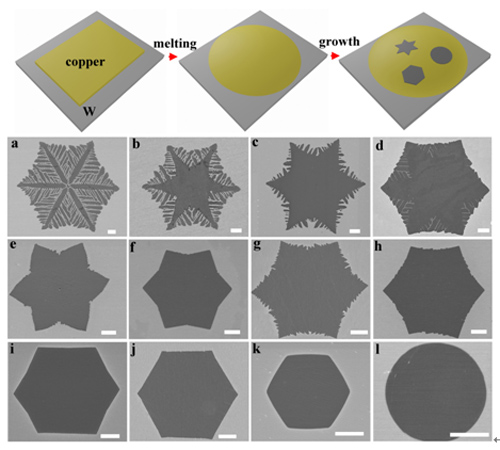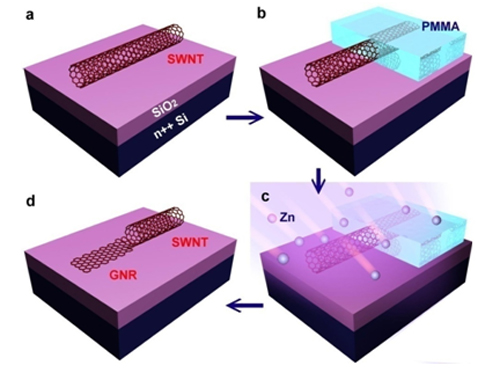The controllable preparation of high-quality graphene is the basis of various basic researches and application developments, and it is one of the major basic scientific issues that urgently requires in-depth study. This area of ​​research involves the control of its size, morphology, boundaries, the degree of crystal structure perfection, doping, etc., in order to achieve its electrical performance control.
With the strong support of the Chinese Academy of Sciences, the Ministry of Science and Technology, and the National Natural Science Foundation of China, in response to these scientific problems, the related researchers of the organic solids laboratory of the Institute of Chemistry, Chinese Academy of Sciences, have been working on the basis of controllable preparation of graphene and Significant progress has been made in performance research. The results were published in Adv. Mater., NPG Asia Mater., J. Am. Chem. Soc. and Nat. Commun.
Graphene is grown directly on the dielectric layer. Chemical vapor deposition (CVD) has become one of the most important methods for the preparation of graphene because it combines the advantages of high quality and macro quantities. However, graphene prepared by this method generally needs to be transferred to other dielectric layers to prepare graphene devices and circuits. The transfer process will cause problems such as graphene damage, wrinkles, contamination, and material waste. Therefore, whether the graphene can be directly grown on the dielectric layer has important scientific significance and huge technical requirements. Graphene is grown directly on the dielectric layer and is compatible with current silicon electronics processing techniques and can be used directly for device fabrication and assembly.
In the previous work, researchers at the Institute of Organic Solids Laboratory invented the oxygen-assisted method to directly prepare graphene films on silicon dioxide insulation materials (J. Am. Chem. Soc. 2011, 133, 17548). It was found that the nucleation sites and crystallite size of graphene can be controlled by two chemical vapor deposition methods, and the high-quality graphene film can be directly grown on the surface of silicon nitride.
The size of the graphene domain crystals in the prepared graphene film was 1 μm. The film has high electrical properties and its mobility can reach 1510 cm2V-1s-1 in air and 1518 cm2V-1s-1 in nitrogen. These properties have been doubled compared to graphene films grown directly on silica substrates and have been higher than that of some metal-catalyzed graphenes. The research results were published in Advanced Materials (Adv. Mater., 2013, 25, 992) and were selected as the inside cover.
Morphology regulation and etching of single crystal graphene. The preparation of monocrystalline graphene and the regulation of its boundary structure are the frontier topics widely recognized in the study of controlled preparation of graphene. The latter goal is particularly confronted with the dual challenges of lack of theoretical guidance and concrete solutions. Researchers at the Chemtronics Solid State Laboratory used the isotropic CVD method of liquid copper surface to prepare regular hexagonal monocrystalline graphene (Proc. Natl. Acad. Sci. USA, 2012, 109, 7992). A series of new thermodynamic graphene metastable structures were obtained for the first time through the regulation of the microscopic kinetics of graphene nucleation and growth (continuous control of the ratio of Ar and H2).
The morphology of this series of graphenes with a high degree of sixfold symmetry follows a definite pattern of change: the graphene boundary variation encompasses a complete range of changes from positive curvature to negative curvature. This graphene pattern system is strikingly similar to the snowflake structure collection in nature, and represents the only example of a known material that perfectly reproduces a snowflake structure set in a two-dimensional manner that is simpler (snowflake is a three-dimensional crystal).
Based on the above facts, the universal growth mechanism of diffusion control is further proposed and is consistent with the theoretical simulation. This work has for the first time linked the growth and morphology regulation of graphene with the kinetic regulation of non-equilibrium systems, revealing a never-found but universally-existing basic rule of graphene growth, which can be generalized to A more extensive two-dimensional atomic crystal material. The related work was published in the "Nature Materials" (NPG Asia Mater., 2013, 5, e36) of the Nature Press Group.

Perfect regulation of the morphology/boundary of monocrystalline graphene
Based on this work, researchers applied this regulation method to the study of graphene etching behavior. The traditional experimental results and concepts suggest that due to the regular arrangement of the building elements, the etching of the perfect crystal behaves as anisotropic etching, and the etching pattern is characterized by a simple Euclidean geometry. The previous experimental results also show that the graphene follows This rule.
The researchers adjusted the ratio of the etching gas H2 to the inert gas Ar, revealing for the first time that the etching pattern of graphene can greatly deviate from the ideal anisotropic etching mode, making the graphene etching pattern from the simple Euclidean From the evolution of structurally complex fractal structures (Figure 3), the simple Euclid etching patterns of graphene observed in previous studies are only special cases of this general evolutionary process. Related work was published in the "J. Am. Chem. Soc. 2013, 135, 6431". The "Chemistry World" of the Royal Society of Chemistry reported the results on the headline of its home page under the heading "Carving graphene snowflakes with gases". "These beautiful snowflakes are not composed of ice but etched from graphene sheets. to".

Graphene fractal etch pattern
Single-walled carbon nanotubes / graphene with intramolecular junctions. Dr. Wei Dacheng of the National University of Singapore and Professor ATSWee collaborated with relevant staff of the organic solids laboratory to prepare single-walled carbon nanotube/graphene ribbon intramolecular junctions (Figure 4). The intramolecular junction shows typical asymmetrical rectification curves ( Switching ratio: ~160,at ±1.5 V). The photocurrent and photovoltage are linearly and exponentially related to the laser intensity. At a light intensity of 98.6 kW/cm2, high photocurrent (11.6 nA) and high light are obtained respectively. The voltage (270 mV) and external photosensitivity of 3 mA/W are higher than those of the two-dimensional graphene or carbon nanotube pn junction, indicating that the intramolecular junction energy is expected to be a high-performance photodetector. The results were published on Nat. Commun. (2013, 4, 1374).

Preparation of single-walled carbon nanotube/graphene ribbon intramolecular junction
This series of work reveals the rich content of graphene growth process under non-equilibrium conditions, providing a broad research space for its further controllable preparation of high-quality, large-area, non-polluting graphene. The results of these studies are also a general reference for the understanding of material growth processes in non-equilibrium systems, and also some basic physical concepts and natural phenomena in graphene and science (such as disorder and order, certainty and randomness, and simplicity To complex, liquid, snow, etc.) are closely linked.
Sectional Door Accessories: motor 220V-380V, control box, spring break device, cable break device , aluminum alloy rope pulley, enhanced shaft bracket, air bag system, duplex enhanced guide wheel bracket.
Detail introduction for above main accessories
1.Motor and controller:
The garage door operator is designed for residential overhead sectional and tilt doors.
The operator memorizes the limit positions and unique braking system that slows the unit down at the end of its travel.
Rolling code remote control with max. 20 pcs hand transmitters.
The operator is equipped with a manual release lever which allows manual operation of the door in case of power failure.
The controller has a security LOCK function which prevents operation of the door from transmitter.
2.spring break device:
Sectional doors are hinged and they bend in the tracks as the door opens and closes. Many of these doors are counterbalanced with extension springs, also designated "stretch springs," and they have seven characteristics. The length is the measurement of all the coils pressed together. This, along with the inside diameter of the coils and wire size - the thickness of the wire from which the springs are made - determine the stretch, the distance the spring is extended - normally half the door height, and pull, the force the spring pulls when stretched its normal length. The type of ends determine how the ends of the spring are mounted. The initial tension is the percentage of pull needed to separate the coils. This is determined by the pitch with which the springs are wound. On sectional garage door springs this is normally 15 percent. For example a 100 pound pull spring requires 15 pounds of weight to separate the coils; when a door is open the two springs will support 15 pounds of door weight without any stretch.
Most extension springs are made of oil tempered wire. These are normally coated or painted. Some springs are made of galvanized wire.
3.able break device:
cable break device ,door hardware
adjustable bottom bracket .
the raw material hot plate
zinc plated
safety device
adjustable bottom bracket
the raw material hot plate
zinc plating
spring safety device ,2" and 3" safety device
once the cable is broken ,this devoice can keep the hurt away from the door falling
4.aluminum alloy rope pulley
Equipment: CNC stamping/punching machine, CNC bending machine, CNC cutting
machine, 5~250 tons punching machines, welding machine, polish machines...
Processed material: stainless steel: copper, carbon steel
Surface treatment: Hot galvanized, polishing
Making process:Stamping, deep drawing,bending, punching, laser cutting,threading,
welding, tapping, riveting, grinding
5.air bag system
It is a safety device. When the door is down to hit something, it will up automatically.
Operation pressure:<3mbar
Battery:CR2032*2
Battery lifetime>1 year
Emission frequency: 315MHZ
Emission power:<10mW
Receiver power source:12V
6.duplex enhanced guide wheel bracket
Determining the right type of sectional door roller for your garage door tracks can be a little confusing, especially when you do not know what you need to look for in a garage door roller. To simplify things, there are two primary things you need to be aware of. First are the actual dimensions of the roller, and second is purpose that you will be using the door for. You can read below about measuring your roller and choosing the right quality of material for your door.
Other Door Accessories,Electronic Door Accessories,Automatic Door Accessories,High Speed Door Radar Detector
Shenzhen Hongfa Automatic Door Co., Ltd. , https://www.hfgaragedoor.com